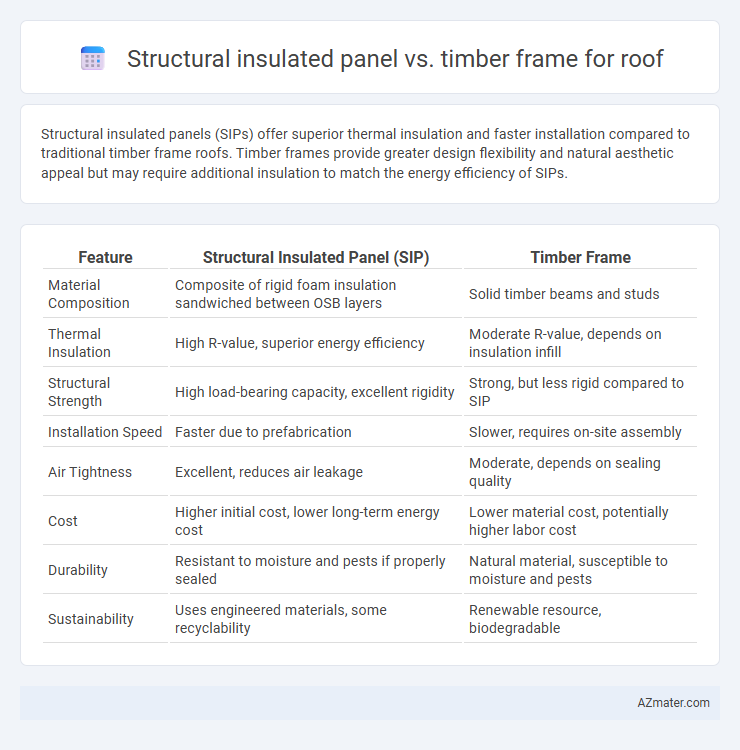Structural insulated panels (SIPs) offer superior thermal insulation and faster installation compared to traditional timber frame roofs. Timber frames provide greater design flexibility and natural aesthetic appeal but may require additional insulation to match the energy efficiency of SIPs.
Table of Comparison
| Feature | Structural Insulated Panel (SIP) | Timber Frame |
|---|---|---|
| Material Composition | Composite of rigid foam insulation sandwiched between OSB layers | Solid timber beams and studs |
| Thermal Insulation | High R-value, superior energy efficiency | Moderate R-value, depends on insulation infill |
| Structural Strength | High load-bearing capacity, excellent rigidity | Strong, but less rigid compared to SIP |
| Installation Speed | Faster due to prefabrication | Slower, requires on-site assembly |
| Air Tightness | Excellent, reduces air leakage | Moderate, depends on sealing quality |
| Cost | Higher initial cost, lower long-term energy cost | Lower material cost, potentially higher labor cost |
| Durability | Resistant to moisture and pests if properly sealed | Natural material, susceptible to moisture and pests |
| Sustainability | Uses engineered materials, some recyclability | Renewable resource, biodegradable |
Introduction to Roof Construction Methods
Structural insulated panels (SIPs) offer efficient thermal performance and rapid installation, making them a preferred choice for modern roof construction. Timber frame roofs provide exceptional flexibility and natural aesthetics, allowing for customized designs and ease of modification during building. Both methods contribute to structural integrity, but SIPs emphasize energy efficiency while timber frames excel in traditional craftsmanship and adaptability.
What Are Structural Insulated Panels (SIPs)?
Structural Insulated Panels (SIPs) are high-performance building components consisting of an insulating foam core sandwiched between two structural facings, typically oriented strand board (OSB). SIPs provide superior thermal insulation, airtightness, and structural strength compared to traditional timber frame construction, making them ideal for roof applications. Their prefabricated nature allows for faster installation and reduced labor costs while enhancing energy efficiency and durability.
Overview of Timber Frame Roofing
Timber frame roofing offers exceptional strength and flexibility, utilizing heavy timber beams that create a durable and aesthetically pleasing structure. This method provides superior thermal insulation and natural breathability, contributing to energy efficiency and moisture control within the building. Compared to structural insulated panels, timber frames allow for easier customization and repair, making them ideal for complex roof designs and long-term maintenance.
Thermal Performance: SIPs vs Timber Frame
Structural insulated panels (SIPs) deliver superior thermal performance compared to timber frame roofs due to their continuous insulation and reduced thermal bridging. SIPs feature rigid foam cores with high R-values, often surpassing R-20, while timber frame roofs rely on cavity insulation that can create thermal gaps. The enhanced airtightness of SIPs minimizes heat loss and improves energy efficiency, making them a preferable choice for roofs focused on insulation effectiveness.
Structural Strength and Durability Comparison
Structural insulated panels (SIPs) offer superior structural strength due to their rigid foam core sandwiched between oriented strand boards, providing excellent load-bearing capacity and resistance to deformation under heavy loads. Timber frame roofs rely on solid wood members that provide flexibility and ease of modification but can be more susceptible to warping, rot, and insect damage over time if not properly treated. SIPs generally demonstrate enhanced durability and consistent performance in harsh weather conditions, resulting in longer-lasting, low-maintenance roofing systems compared to traditional timber framing.
Installation Speed and Ease
Structural insulated panels (SIPs) offer faster installation compared to timber frame roofs due to their pre-fabricated, lightweight design that reduces on-site assembly time. Timber frame construction involves more complex joinery and sequential framing processes, which can extend the installation period and require skilled labor. SIPs also simplify weatherproofing and insulation integration, enhancing overall ease of installation for roofing projects.
Cost Analysis: SIPs vs Timber Frame
Structural insulated panels (SIPs) offer a higher upfront cost compared to traditional timber frame roofs, primarily due to factory fabrication and specialized materials. Timber frames may have lower initial expenses but often incur higher labor costs and longer construction times, increasing overall project expenditure. Long-term energy savings from SIPs' superior insulation can offset initial costs, making them more cost-effective over the building's lifecycle.
Environmental Impact and Sustainability
Structural insulated panels (SIPs) offer superior thermal performance and reduced energy consumption compared to traditional timber frame roofs, significantly lowering carbon footprints over the building's lifespan. SIPs typically use foam insulation with higher embodied energy, but their airtightness and efficiency contribute to long-term environmental benefits. Timber frame roofs rely on renewable, biodegradable wood materials with lower embodied energy, making them a sustainable choice when sourced responsibly and managed through certified forestry practices.
Design Flexibility and Architectural Possibilities
Structural insulated panels (SIPs) offer limited design flexibility due to their prefabricated, panelized nature, making them ideal for straightforward roof shapes but challenging for complex architectural designs. Timber frame roofs provide extensive design flexibility, supporting intricate geometries, custom detailing, and a wide range of architectural styles through their adaptable joinery and on-site modifications. Architects often prefer timber frames for unique roof structures requiring curves, varying slopes, or exposed timbers, while SIPs excel in energy efficiency and speed of installation for simpler roof designs.
Conclusion: Choosing the Right Roof Construction Method
Structural insulated panels (SIPs) offer superior thermal insulation and faster installation times, making them ideal for energy-efficient roof construction. Timber frame roofs provide greater design flexibility and are often more cost-effective for custom or complex structures. Selecting between SIPs and timber framing depends on project priorities such as budget, energy performance goals, and architectural requirements.

Infographic: Structural insulated panel vs Timber frame for Roof
 azmater.com
azmater.com